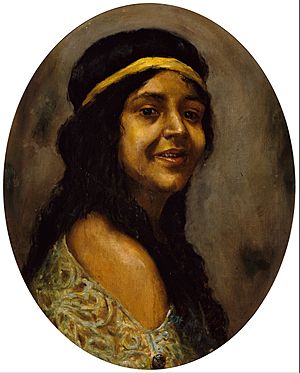Edwin Harleston facts for kids
Edwin Augustus Harleston (born 1882, died 1931) was an important American artist. He helped start the NAACP in Charleston, South Carolina. Harleston was famous for his realistic portraits, which looked like classic paintings. Even though he was a talented artist, he was not allowed to join the main art group in Charleston, called the Charleston Renaissance, because of his race.
Early Life and Family
Edwin Harleston was born in Charleston, South Carolina, on March 14, 1882. He was one of five children. His father, Edwin Gaillard Harleston, owned a successful funeral home. The family was well-known in Charleston. Edwin's family called him "Teddy" to tell him apart from his father.
Edwin won a scholarship to study at the Avery Normal Institute. He graduated as the top student in 1900. After that, he went to Atlanta University. There, he studied chemistry and sociology. He also took classes with W. E. B. Du Bois, who became a close friend.
After college, Harleston returned to South Carolina in 1913. He helped his father run the funeral home. He even went to a special school in New York to learn about embalming. He worked at the funeral home until 1931, the year he and his father both passed away.
In 1917, Edwin became the president of the new NAACP branch in Charleston. He led a successful effort to get black teachers hired in the local public schools. In 1918, he adopted his niece, Gussie. Her parents were ill. Gussie later changed her name to Edwina to honor her adoptive father.
Education and Art Training
Edwin Harleston came from one of the few well-known Black families in Charleston at the time. He attended the Avery Normal Institute, a private school. While there, he painted a picture called Lincoln and His Cabinet. This showed his early interest in painting scenes about Black culture in the South.
He then went to Atlanta University for college. Even though the university did not have an art program, Edwin kept drawing and painting. It was at this school that he met W. E. B. Du Bois. Du Bois encouraged Harleston to use his talents to help his community.
Harleston wanted to study painting at Harvard University. He was accepted to Harvard, but he chose to attend the Boston Museum of Fine Art's school instead. Harvard wanted him to start as a freshman, saying his previous college education was not enough for graduate art studies. He was quickly accepted into the Boston school.
From 1905 to 1912, he studied under famous painters like William McGregor Paxton and Frank Weston Benson. He also learned anatomy. Edwin also took classes at the Art Institute of Chicago during the summer. All of his art teachers were white. At the Boston Museum of Fine Arts School, Harleston was the only Black student in his class. He was also from the South, while most of his classmates were from the North. Boston had many art museums, which helped Harleston develop his painting style. He was inspired by artists like Rembrandt.
Art Career and Style
Harleston painted in a realistic style. His training in Boston and his wife Elise Forrest Harleston's photography influenced his work. He mostly painted portraits, often for people who asked him to. Some of the people he painted included Grace Towns Hamilton, who became the first African-American woman elected to the Georgia General Assembly.
It was hard for Harleston to paint regularly while working at the funeral home. But he returned to art in his thirties after meeting Elise Forrest. When he started painting again, he found his skills were still strong. He painted his family members and scenes of daily life for African Americans in Charleston. He also painted landscapes of the South Carolina Lowcountry.
Harleston believed in showing Black people and their lives in a realistic way. He followed the tradition of artists like Henry Ossawa Tanner. W. E. B. Du Bois called Harleston the "leading portrait painter of the race." However, because he helped run the funeral home, he could not be a full-time painter.
In 1920, Harleston married photographer Elise Forrest. They opened an art studio together. This studio was the first public art place for African Americans in Charleston. Harleston often used Elise's photographs as ideas for his paintings. One of his most famous works, Miss Sue Bailey with the African Shawl, was based on one of Elise's photos. This painting shows how Harleston wanted to portray his subjects with dignity.
In 1930, Harleston helped artist Aaron Douglas paint large murals for Fisk University. These murals are now considered very important works by Douglas. Harleston even painted a portrait of Douglas with the unfinished mural in the background. This showed Harleston's ability to use different colors and styles when working with other artists.
Harleston won several awards for his art. He won top prizes in NAACP contests in 1925 and 1931. He also won the William E. Harmon Foundation's Alain Locke Prize for portrait painting in 1931.
Despite his success, Harleston was mostly left out of the white art groups of the Charleston Renaissance. This was due to racial prejudice and segregation. A planned art show of his work at the Charleston Museum in 1926 was canceled because of these issues.
By 1930, the funeral home business was struggling because of the Great Depression. Harleston gave talks at Black colleges to earn money. In April 1931, his father died from pneumonia. Less than a month later, Edwin Harleston also passed away from the same illness at age 49.
Legacy
Today, Edwin Harleston's paintings can be seen in several art collections. These include the Gibbes Museum of Art and the Avery Research Center for African American History and Culture in Charleston. His art is also at the Savannah College of Art and Design Museum and the California African American Museum.
His personal papers are kept at the South Carolina Historical Society and Emory University's Stuart A. Rose Manuscript, Archives, and Rare Book Library.


